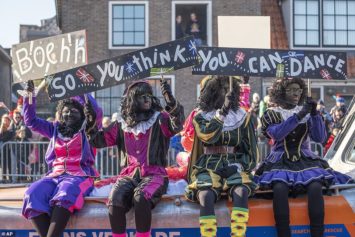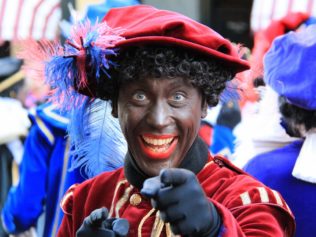
Dutch locals celebrate the Christmastime tradition of Zwarte Piet. Image courtesy of Reuters.
Every year at Christmastime, countless numbers of Dutch locals don frilly black wigs, ruby red lips and charcoal-black skin in celebration of Zwarte Piet — a Dutch tradition in which adults and children playfully tout costumes portraying the dark-skinned helpers of St. Nick.
For obvious reasons, critics of the tradition have long called it racist, arguing that blackface is a distasteful play on negative racial stereotypes rooted in the country’s not-so-distant ties to colonialism and slavery. On the other hand, a large majority of the Dutch public see no issue with the celebration, asserting that the legends of St. Nick and Black Pete predate the era of colonization and enslavement of African peoples.
Dutch leaders have been reluctant to acknowledge the tradition’s racist ties, giving minority groups all the more reason to raise hell over the matter. Organized protests have rocked St. Nicholas celebrations in recent years — and it looks like the backlash has finally caught the attention of a few world leaders.
According to the Washington Post, a United Nations racial discrimination committee convened in Geneva last August and urged the Dutch government to “promote the elimination of those features of the character of Black Pete which reflect negative stereotypes and are experienced by many people of African descent as a vestige of slavery.”
Late last year, Dutch primary schools also banned children sporting the physical characteristics of Black Pete, such as his curly hair, blackened skin, red lips and gold hoop earrings, France24.com reports. Now the country’s ombudswoman for children is arguing that the entire tradition of Zwarte Piet is a violation of children’s rights.
Margrite Kalverboer, the ombudswoman, issued a report Friday suggesting that the tradition of Black Pete be “stripped of discriminatory or stereotypical characteristics.” Otherwise, the Netherlands risks violating children’s rights to fair treatment and protection from discrimination, according to the Washington Post.
“The figure of Zwarte Piet can contribute to bullying, exclusion or discrimination, and is therefore contrary to the CRC,” the report reads. “[Kalverboer] has spoken with many [children of color] who experience discrimination in their daily lives and say that it’s worse around Sinterklass time.”
The report went on to state that several Black children found the typical characteristics and buffoonish behavior of Black Pete to be “negative and discriminatory against people with dark skin.”
Over the years, other efforts have been made to thwart the offensive traditions of Zwarte Piet and blackface, such as the website StopBlackface.com, which aims to bring attention to the racially offensive practice, and a CNN Digital short film by African-American filmmaker Roger Ross Williams titled, Blackface, Atlanta Black Star reports.
Yet still, many Dutch locals don’t understand how the tradition could be deemed racist. Last year, Sven Gatz, the Flemish minister of Culture, tweeted a photo of himself dressed as Black Pete, donning blackened skin and bright red lips. When he received swift backlash from the international community, he wrote, “Engaged against racism all my (political) life. And now I’m an ordinary racist because I coloured my face dark. Come on. Love. Don’t hate.”


